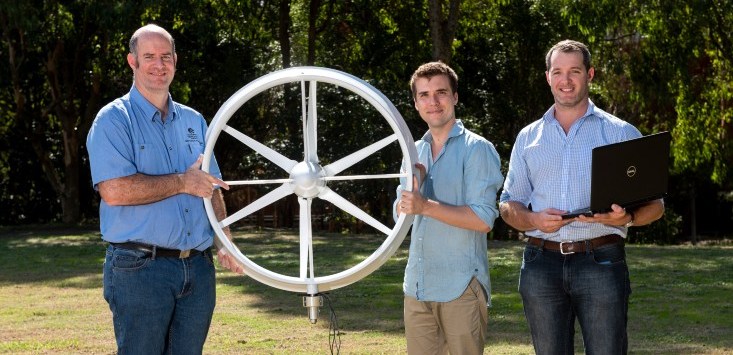
Diffuse Energy co-founders James Bradley, Sam Evans and Joss Kesby. Source: supplied.
Wind turbine startup Diffuse Energy has secured $400,000 in seed funding for its off-grid power solution that helped keep emergency services connected during this summer’s bushfire crisis.
The startup produces wind turbines that span less than a metre. The blades are enclosed within a diffuser, meaning more air is drawn through the turbine, creating more power while taking up minimal space.
Co-founder and chief Dr Joss Kesby tells SmartCompany the technology was born out of his own PhD research at the University of Newcastle.
For the past couple of years, Kesby and co-founders Dr Sam Evans and James Bradley have been working on commercialising the product, coming through the CSIRO ON accelerator program.
The team’s initial market is the telecommunications sector, specifically to provide power to remote towers in the middle of the bush, or in the mountains, which are tricky to connect to the grid.
Typically, these locations use solar power and batteries to produce their power, he explains, but space constraints mean they don’t generate enough energy. Telecoms providers end up relying on diesel to fill the gap.
That diesel is usually the number one operational expense for a site, Kesby explains.
“It also creates a problem with energy resilience,” he says.
During the bushfire crisis of last summer, for example, communications were disrupted, but not because sites burnt down. Rather, people couldn’t get to them to top up the fuel.
Even for towers that were powered by the grid, if the bushfires destroyed the lines that ran to them, they lost power too.
In fact, in last summer’s devastating bushfire crisis, the Diffuse Energy team proved the value of their product, working with critical network services provider Vertel to power communication and data services for New South Wales Police and other emergency services.
Now, as of last month, the business has some sales on the board and is looking to ramp up its growth.
Supply chain challenge
The $400,000 seed funding will mainly be used to scale up the startup’s manufacturing.
“We’re currently doing pretty low volume manufacturing, which is quite expensive,” Kesby says.
“We’re also getting a lot of interest from a whole range of different telcos and different customers, so if we can improve our pricing and the profitability of our product then we can look at larger volumes of manufacturing,” he adds.
“There are some significant cost savings when you get to larger volumes.”
But, of course, all Aussie businesses are facing a whole new crisis now. The COVID-19 pandemic has got Kesby thinking a bit more carefully about his supply chains, and where their parts are coming from.
About 80% of the product is manufactured in Australia, he says.
“There are some components we haven’t been able to source in Australia, let alone at a price that competes.”
But, when looking at scaling up manufacturing, “the supply chain has been a really important aspect of what we’re looking at”.
Existing supply chains have in fact been affected by the pandemic, with crucial components being “locked up in China” for some time, Kesby explains.
“It’s really made us aware of where every component is made and where it’s coming from, and that has altered our thinking in how we protect against that in the future.”
Renewable and resilient
At the same time, while renewable energy solutions and action on climate change was in the spotlight in 2019, when hundreds of thousands of students and businesses took part in the Climate Strike to protest inaction, the pandemic has perhaps drawn attention elsewhere.
Kesby says it has had an effect on business for Diffuse Energy — but not in the way you might think.
The telecommunications industry in general has been more than ever trying to keep networks up and running and managing the unprecedented demands of lockdown.
“We’ve actually found that it has had an impact on us talking to customers, but only because they’re so busy,” Kesby says.
“Trying to sell into that market is a challenge. We’re getting a lot of really good interest from the telcos, and they’re also coming to us to talk about how we can help them,” he adds.
“The challenge is getting it to the front of the queue.”
Needless to say, this wasn’t something the cofounders anticipated in the business plan.
“It’s not something we had expected, but who knows what to expect in a pandemic? It’s totally uncharted territory.”
And, while renewable energy may not be front of mind anymore, that was never at the centre of Diffuse Energy’s sales pitch.
Rather, the focus is on the savings a telco could see.
“If we can save them money, or compete with their biggest cost … that makes a hell of a lot of sense,” Kesby says.
“Then, you don’t have to try and explain to the company why your product is better for the environment.”
It’s also about energy resilience. And while summer may feel like a lifetime ago now, memories of the bushfire crisis are still fresh.
Telecommunications is one of the main areas under scrutiny in the Royal Commission into the crisis, Kesby explains.
“Energy resilience is a really key issue for telecommunications companies, and that’s what they’re talking to us about.”


COMMENTS
SmartCompany is committed to hosting lively discussions. Help us keep the conversation useful, interesting and welcoming. We aim to publish comments quickly in the interest of promoting robust conversation, but we’re a small team and we deploy filters to protect against legal risk. Occasionally your comment may be held up while it is being reviewed, but we’re working as fast as we can to keep the conversation rolling.
The SmartCompany comment section is members-only content. Please subscribe to leave a comment.
The SmartCompany comment section is members-only content. Please login to leave a comment.